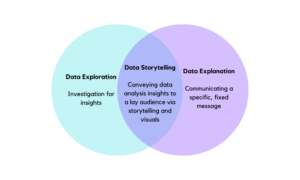Introduction
Data Literacy is the ability to read, write, understand, and communicate with data effectively so that information is used to enable quick business decisions and business outcomes. To put it simply, Data Literacy is really about the skills and competencies
to work with data and information.
The need for Data Literacy today is extremely important due to the “digital-first” world that we live in, and organisations making every possible effort to bring in transformation and innovation to survive in the highly competitive environment. The efficacy
and desired outcomes of various Initiatives like Analytics, Big Data, Cloud, IoT, Data Visualisation, Artificial Intelligence and Machine Learning and Digitalization rest on good data, which is something that most organisations are still struggling with, despite
efforts made in this direction. And this is where Data Literacy steps in- as a foundational block that enables organisations to foster a data driven culture and leverage data which is today a persistent part of our everyday life.
Digitalization depends on data, and how…
We live and operate in a super and hyperconnected world where tons and tons of data is generated at every touch point or interaction. And organisations are making efforts to leverage this data that is generated, to serve their customers better and improve
the experience of each interaction. However, due to the lack of knowledge on how to use data, most organisations cannot use data to augment their business and grow and find their digitalization initiatives do not achieve the desired outcomes. In fact, a Forrester
survey found that “Firms make fewer than 50% of their decisions based on quantitative information as opposed to gut feeling, experience, or opinion.” Further, 85% of those surveyed wanted to improve their use of data insights in their decision making, but
91% reported that improving the use of data insights in decision making was challenging.
In the old order, data was usually used for reporting and analytics, more for internal consumption and to some extent for the customers. But in this fast-changing world that we exist in, customers expect faster, more customised delivery of products and services,
quick decisions, a digital first environment that propels self-service, combined with security and privacy. This requires organisations to up their game in terms of usage of analytics, digital platforms, automation in the form of robotics and machine learning
to deliver better, more personalized outcomes.
Data is therefore a critical component of any transformation effort as data enables one to create patterns, baselines, and benchmarks for every step in the transformation journey and helps track progress of such programs. Thus, it’s time to wave the wand
and weave the magic.
Data Literacy – the magic wand that is there to help
Data Literacy and Digitisation are two sides of the same coin. To compete in a digital and AI world, organisations need to use data scientists that can work with data to create competitive advantages for their enterprises, in the form of informed and intelligent,
data-driven business decisions to improve customer journeys and the experience, create customized offers and deliver seamless cross
channels products/ and services. And for this, organisations need to equip their staff with digital competencies, with Data Literacy taking centre stage as an important knowledge base for all employees.
Various surveys that have been conducted on the need or importance of Data Literacy reflect that business leaders believe that data literacy is extremely critical for their future business needs and growth and expect their teams to make data-driven decisions.
Employees (not just Data Scientists) who are comfortable using data will generate outstanding business benefits and Data Literacy initiatives and trainings will upskill the employees to contribute to the company’s bottom line and key business KPIs in the
long term.
The diagram given below details a typical Data Literacy program:
Data Literacy Program in a nutshell – Diagram #1
For Data Literacy to be successful, it is critical for organizations to create a strong foundation of Data Governance (policies, processes, clear ownership, access controls for data democratization, data standardization and more), which is in sync with the
vision/mission of the enterprise and based on a robust Data Strategy. Data Governance is the all-important pillar that ensures data is managed as an enterprise asset and contributes significantly to the success of any data literacy program.
Investing in Data Literacy will yield several benefits to an organization, and the key ones are listed below:
Benefits of Data Literacy
- A data literate workforce that understands how to source, use and exchange data and make ethical data decisions
- Ease in interacting with data and creating a self-service capability
- Enables employees to take data-driven decisions
- Help bring in the competitive edge to thrive in an aggressively competitive environment
- Ability for the workforce to understand, implement and measure the digitalization and innovative efforts of the organization
- Increase the organizations skill map and data maturity
- Create an empowered and loyal workforce
- Enable use of various intuitive tools, technologies and assets to the maximum, which will help the data management lifecycle
While the benefits will roll in, let’s understand, through an example, why Data Literacy is important for any organization.
If only ABC Bank had invested in Data Literacy too – an example
The changing times have witnessed a shift to digital channels in Banking (and other industries too). Many organizations invested in all the possible options available in technology but are still grappling with customer expectations on personalized delivery
of products and services. While banks generate a goldmine of data internally, and can also leverage external data, they still fall short on customer’s expectations. And the reason for this is that banks have not invested enough in creating a data-driven organization,
which integrates data into each business unit, and trains their staff to read, understand and use data for business growth. And this is where Data Literacy steps in.
Let’s understand this through an example: Bank ABC has heavily invested in technology to create a digital – first banking experience for its customers. The Bank has also invested in new-age technology like data mining tools, AI, Cloud technology and more.
ABC Bank has set ambitious targets on revenue and growth and wants to be the preferred bank of its customers. Hence, the Bank is evaluating its product portfolio to make it more cutting edge and relevant for future growth.
Mr A, who works in product Strategy and Design with ABC Bank needs to decide on retiring a product Z, that is not reflecting any growth in numbers/revenue. While this was a top line product in the recent past, the trajectory has since been downhill. Product
Z is a savings linked investment product that has been giving less than average returns. ABC Bank has not been able to leverage technology to the fullest and bring in the required automation or the skills to change the product parameters (even manually) towards
more favourable investments options (like a swing towards market linked products like stocks, commodities, foreign exchange and others considering factors like market risks, credit risks, investment objectives and time horizon, risk profile, portfolio diversification,
asset allocation strategy etc.).
Mr A felt that Product Z could be tweaked with some additional features (mapping product and market risk, with customer’s risk profile, investment objectives and time horizon) and investment options (like linking it to a stock theme and bringing in a suite
of commodities to the investment options) and re-introduced as a structured product. The product would then contribute significantly towards the Banks vision. However, Mr A was not sure on how to access and use all the required information to take this decision
and create a business case to modify the product features, instead of retiring it. He did not have the required data and thus the confidence to ask the right questions and challenge the decisions of the management to retire the product. Additionally, there
was no collaborative community within the Bank that Mr A could reach out to for help. Hence, Mr A decided to retire the product.
While ABC Bank had invested in the required tools and technology stack to create a digital imprint, the Bank did not focus on setting a strong base to manage data. Overlooking the critical pillars of Data Governance (democratizing data) and Data Literacy
(ability to leverage data as an enabler for business decisions and using technology to the maximum, Mr A was unable to take the right business decision. If ABC Bank had invested in trainings, and other collaborative methods to equip their staff with the skills
required to source, manage and use data as an asset, Mr A would have successfully added the required features and parameters to the existing product Z and helped the Bank achieve its vision in a far lesser time and reduced efforts.
Hence, one cannot stress enough the need for Data Literacy in organizations. Data Literacy trainings and events are important to upskill employees and raise the data literacy index / quotient through a customized assessment framework that will consider the
current maturity level and the aspired level of maturity that the organization hopes to achieve. The framework should span across variables like technical skills, behaviour mapping, relationships and mindset of the employees, visual data thinking, ethics in
data, risk and compliance, data security, and come up with a digital fitness assessment score that determines the level of maturity in managing data as an asset. Once the score is ascertained and a baseline created, the gaps can be identified to create customized
training plans that will address each gap and help improve the score through various upskilling programs. These events need to be repeated after a time gap to ensure continuous improvement and upskilling of employees.
While the assessment framework will help organizations assess their current data literacy quotient, and help determine the opportunities for improvement, it is imperative that organizations create a base for implementing the various re-skilling opportunities
through a robust and detailed strategy and plan. This strategy and plan must be reviewed at a pre-determined frequency; preferably yearly to maintain the momentum of raising the Data Literacy index across the enterprise and create a data DNA. And organizations
need to put in place, a few basics (apart from the training programs and other initiatives) to ensure the success of Data Literacy initiatives. Given below is a list of “must-do’s” that organizations need to keep in mind to ensure the success of data literacy
initiatives.
The re-skilling roadmap for Data Literacy
Some of the initiatives that organizations can pursue to improve the data literacy rate are:
- Ensuring C-suite support
- Defining ownership
- Assessing / baselining employee’s skills
- Hiring Data Visionaries
- Explaining the “why” behind Data Literacy
- Providing access to Data Literacy training courses
- Expanding access to data with the organization
- Encouraging questions on data
- Working towards IT/business collaboration
- Investing in the right self-service data tools
- Starting small and continuously assessing progress
- Remembering that Data Literacy does not exist in isolation – it includes data maturity and walking the talk, especially at the leadership level
While there are several more initiatives that can be added to the roadmap, the idea is to get started and continue with baby steps. This investment in Data Literacy will ensure that the organization will have far more data-driven individuals who will leverage
data and successfully manage and implement transformation / innovation programs that lead to an improvement in the key customer, revenue, and growth KPIs of the organization. So go ahead, take the pledge to make your organization more data focussed and let
the benefits roll in.
- ant financial
- blockchain
- blockchain conference fintech
- chime fintech
- coinbase
- coingenius
- crypto conference fintech
- fintech
- fintech app
- fintech innovation
- Fintextra
- OpenSea
- PayPal
- paytech
- payway
- plato
- plato ai
- Plato Data Intelligence
- PlatoData
- platogaming
- razorpay
- Revolut
- Ripple
- square fintech
- stripe
- tencent fintech
- xero
- zephyrnet












